Abstract
Reasons for the accumulation of mercury-resistant strains of Staphylococcus aureus in hospital have been studied. A collection of paired strains, that is staphylococci similar in every respect except sensitivity to mercury salts, was made. Tests were made in an attempt to demonstrate a link between mercury resistance and some other factor which might aid survival, viz. resistance to drying and heat, production of bound coagulase, growth in the presence of sublethal amounts of tetracycline, survival in human blood at 37° C. and uptake by polymorphs at 30° C. and 37° C., development of resistance to antibiotics and competition in mixed cultures. It was not possible to demonstrate any consistent link between mercury resistance and any of these properties. Paper strips impregnated with the mercurial diuretic, Mersalyl, were shown to differentiate between mercury-resistant and -sensitive strains in vitro. Furthermore, development of resistance to mercury by passage in mercuric chloride-broth was demonstrated.
It is proposed that mercury resistance has developed as a result of exposure to the mercury ion. Mercurial diuretics have been frequently used in medical and geriatric patients and it is among these that the higher carrier rates of mercury-resistant strains are found even when the local endemic strain is disregarded. In obstetric patients, where mercurials are seldom used, mercury-resistant strains are rare.
Nasal carriage of factory workers exposed to mercury products showed that this group is likely to carry resistant or partially resistant strains.
Full text
PDF
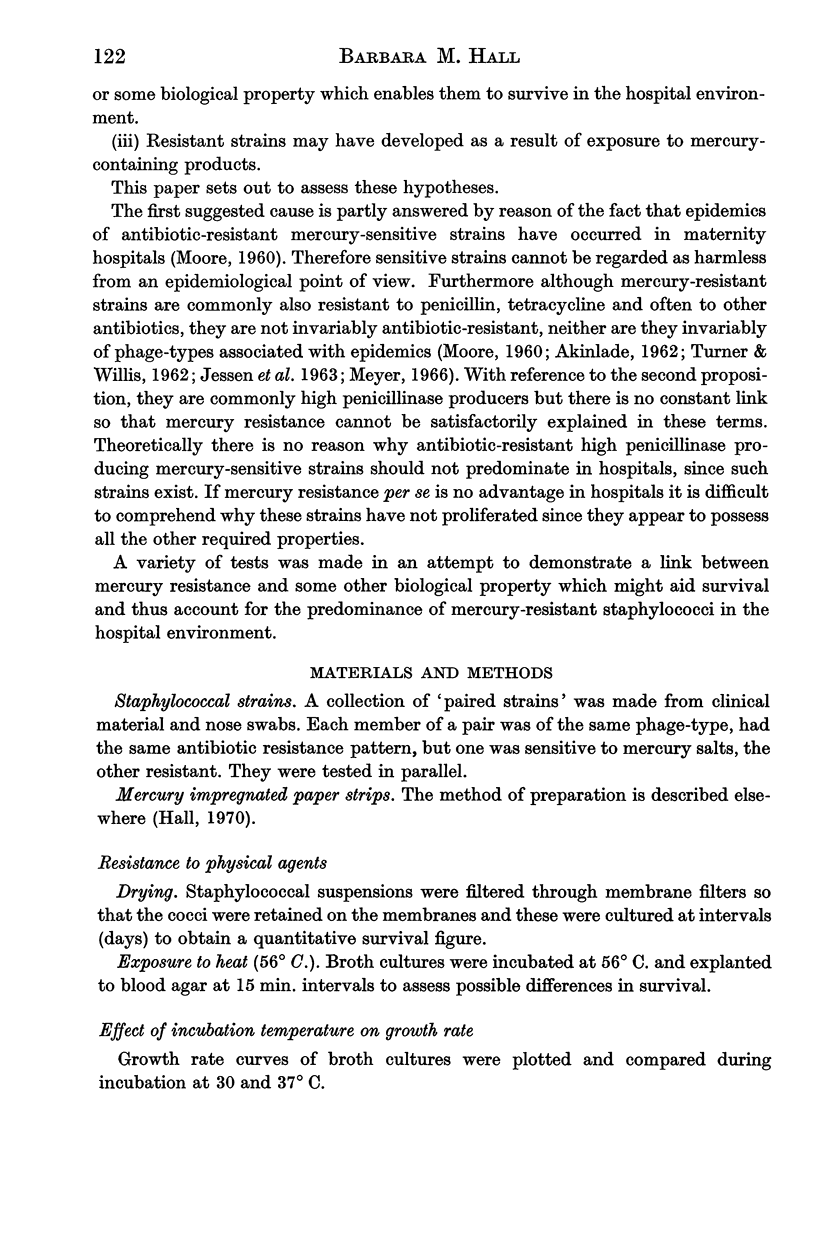
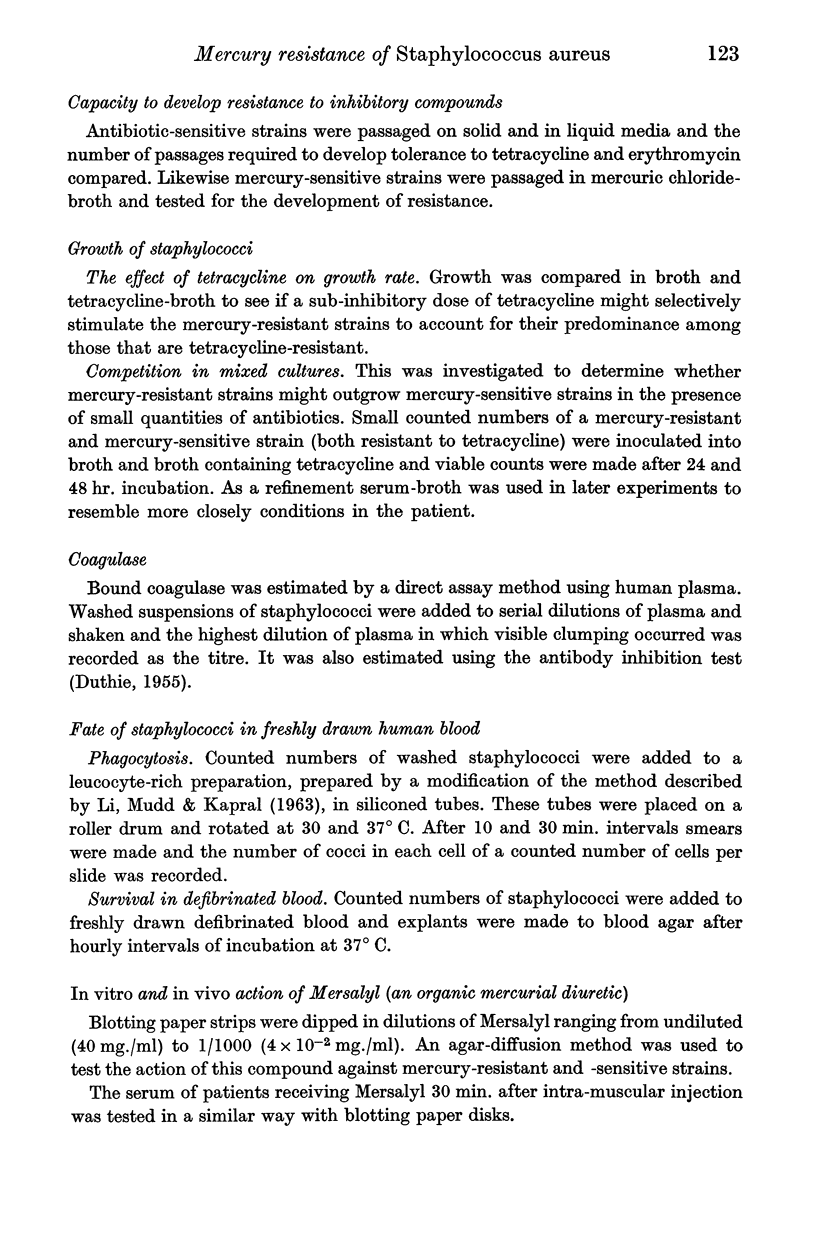
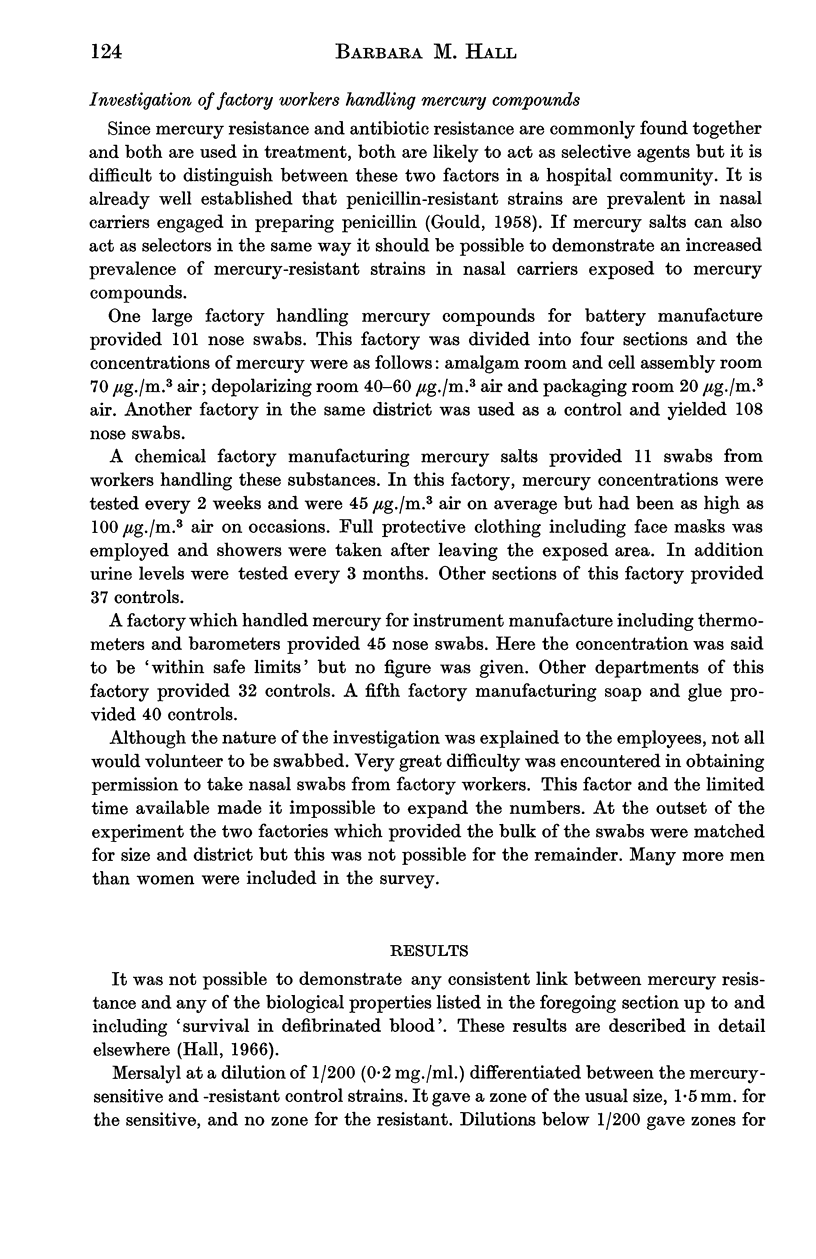




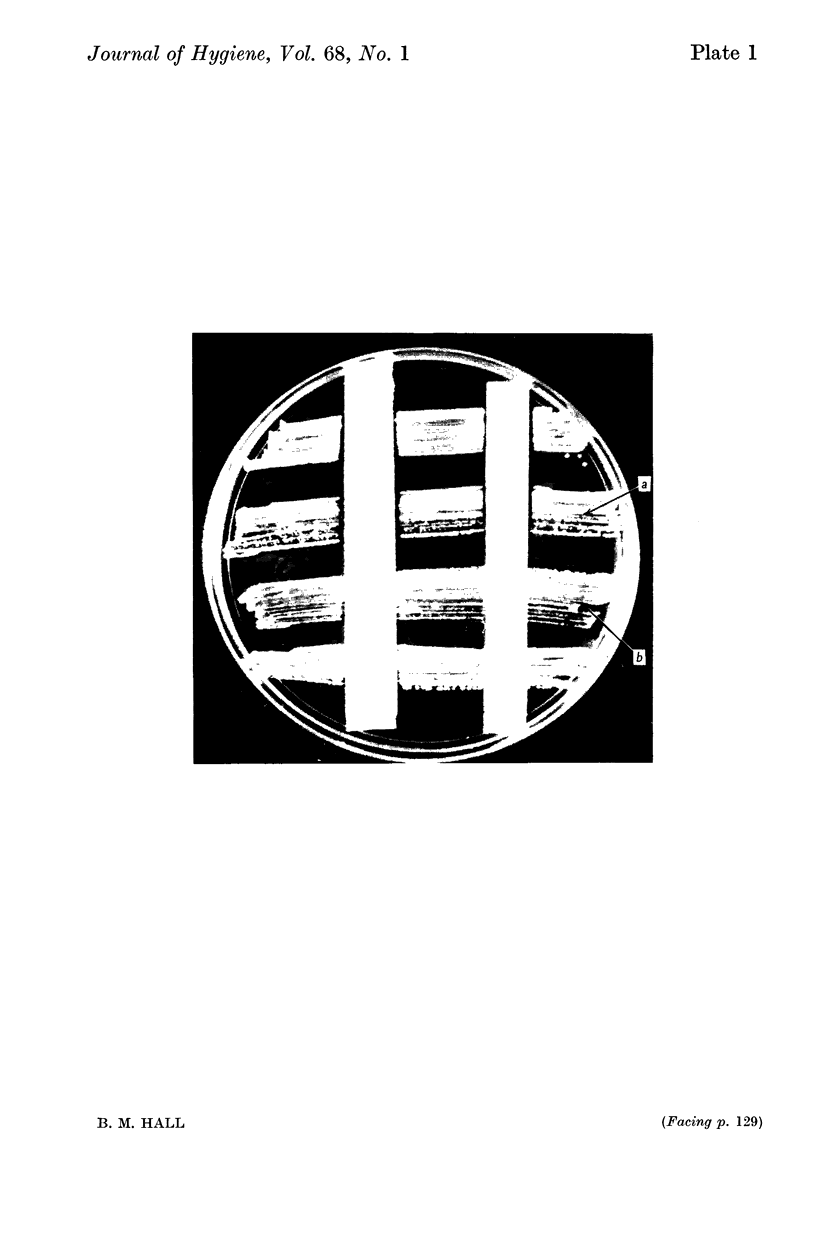
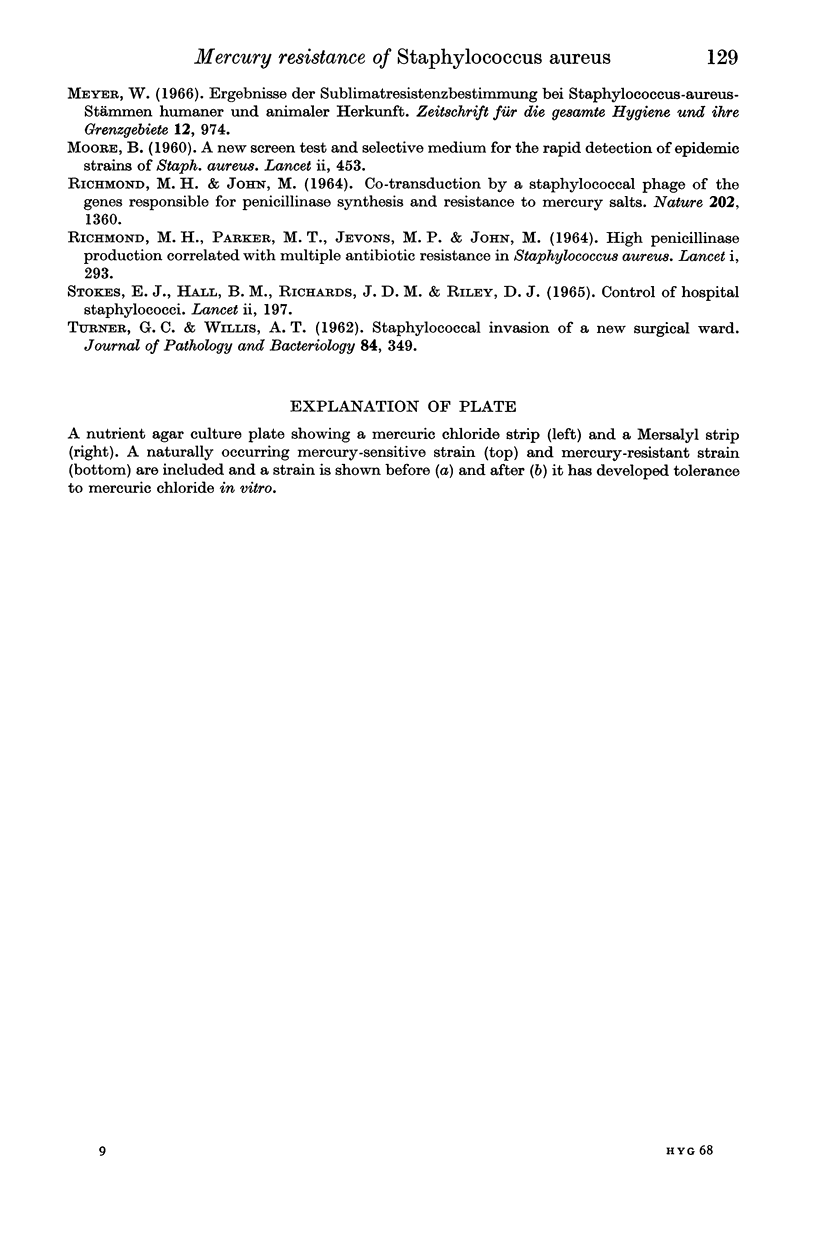
Images in this article
Selected References
These references are in PubMed. This may not be the complete list of references from this article.
- AKINLADE N. D. A trial of mercuric chloride for the rapid identification of epidemic strains of Staphylococcus pyogenes. West Afr Med J. 1962 Feb;11:35–38. [PubMed] [Google Scholar]
- DUTHIE E. S. The action of fibrinogen on certain pathogenic cocci. J Gen Microbiol. 1955 Oct;13(2):383–393. doi: 10.1099/00221287-13-2-383. [DOI] [PubMed] [Google Scholar]
- GOULD J. C. Environmental penicillin and penicillin-resistant Staphylococcus aureus. Lancet. 1958 Mar 8;1(7019):489–493. doi: 10.1016/s0140-6736(58)90807-9. [DOI] [PubMed] [Google Scholar]
- JESSEN O., ROSENDAL K., FABER V., HOVE K., ERIKSEN K. R. Some properties of Staphylococcus aureus, possibly related to pathogenicity. 3. Bacteriological investigations of Staphylococcus aureus strains from 462 cases of bacteraemia. Acta Pathol Microbiol Scand. 1963;58:85–98. doi: 10.1111/j.1699-0463.1963.tb04830.x. [DOI] [PubMed] [Google Scholar]
- LI I. W., MUDD S., KAPRAL F. A. DISSOCIATION OF PHAGOCYTOSIS AND INTRACELLULAR KILLING OF STAPHYLOCOCCUS AUREUS BY HUMAN BLOOD LEUKOCYTES. J Immunol. 1963 May;90:804–809. [PubMed] [Google Scholar]
- MOORE B. A new screen test and selective medium for the rapid detection of epidemic strains of Staph. aureus. Lancet. 1960 Aug 27;2(7148):453–458. doi: 10.1016/s0140-6736(60)91591-9. [DOI] [PubMed] [Google Scholar]
- Meyer W. Ergebnisse der Sublimatresistenzbestimmung bei Staphylococcus-aureus-Stämmen humaner und animaler Herkunft. Z Gesamte Hyg. 1966 Nov;12(11):974–981. [PubMed] [Google Scholar]
- RICHMOND M. H., JOHN M. CO-TRANSDUCTION BY A STAPHYLOCOCCAL PHAGE OF THE GENES RESPONSIBLE FOR PENICILLINASE SYNTHESIS AND RESISTANCE TO MERCURY SALTS. Nature. 1964 Jun 27;202:1360–1361. doi: 10.1038/2021360a0. [DOI] [PubMed] [Google Scholar]
- RICHMOND M. H., PARKER M. T., JEVONS M. P., JOHN M. HIGH PENICILLINASE PRODUCTION CORRELATED WITH MULTIPLE ANTIBIOTIC RESISTANCE IN STAPHYLOCOCCUS AUREUS. Lancet. 1964 Feb 8;1(7328):293–296. doi: 10.1016/s0140-6736(64)92407-9. [DOI] [PubMed] [Google Scholar]
- STOKES E. J., HALL B. M., RICHARDS J. D., RILEY D. J. CONTROL OF HOSPITAL STAPHYLOCOCCI. Lancet. 1965 Jul 31;2(7405):197–201. doi: 10.1016/s0140-6736(65)90691-4. [DOI] [PubMed] [Google Scholar]
- TURNER G. C., WILLIS A. T. Staphylococcal invasion of a new surgical ward. J Pathol Bacteriol. 1962 Oct;84:349–358. doi: 10.1002/path.1700840209. [DOI] [PubMed] [Google Scholar]



